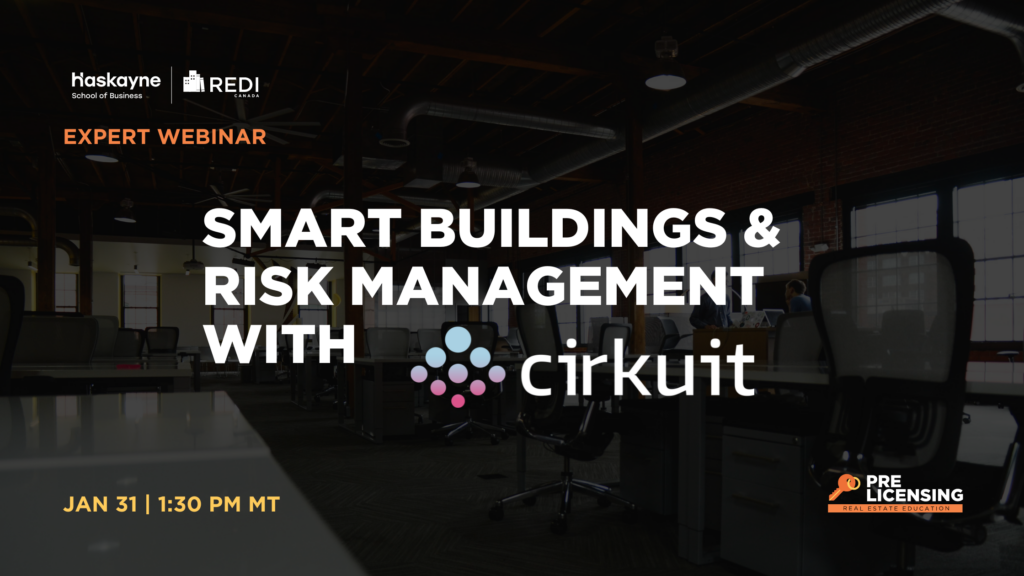Smart Buildings & Risk Management, with cirkuit
Adam Ludgate and Brad Gauthier, the co-founders of Calgary-based proptech company cirkuit Inc. joined REDI Canada’s Manager, Industry Relations, Amanda Blacktopp, CPM, to discuss how smart solutions are addressing challenges in multi-family, property management, and condominium management spaces.
REDI Canada + Haskayne School of Business pre-licensing learners and graduates can access the full webinar recording through their course portals or the REDI Pre-licensing Learner & Alumni Network LinkedIn group to learn more about how cirkuit got started and how smart building technology relate to licensee’s activities. The following excerpts are edited for clarity and brevity.

What challenges can technology like cirkuit’s address for licensees and their clients?
The biggest challenges are around keeping people (and buildings) healthy and safe, so things like water leaks and temperature issues (freezing pipes), security, indoor air quality (IAQ), and ESG (environmental, social, and governance) and occupancy monitoring.
Water Events
Cirkuit began with a primary focus on trying to reduce risk in buildings by using Internet of Things technology to detect water leaks. We found some research showing that something like 40% of all insurance payouts in commercial multi-family across Canada are related to water events. At the time, the multi-family market had limited offerings like this, as opposed to the home residential market, where renters and home buyers can get all kinds of home devices that they can just hook up to Wi-Fi and be self-set up in an hour. When it comes to scalable solutions for multifamily and commercial assets, we felt the market lacked good solutions. And today, we have a whole variety of other things that we can monitor.
Security
We’re seeing a tremendous amount of interest in security functionality that hopefully reduces costs for physical onsite security guards. For instance, there’s interest in real-time monitoring for “unmanned” industrial warehouse facilities where people are typically required to drive around and check on them. Or, things like security camera monitoring and stuff that can be hourly rates, day rates, or monthly rates can add up to pretty significant costs. We’re essentially trying to simplify everything down to the point where we can solve a problem without someone necessarily being there.
Indoor Air Quality (IAQ)
As it pertains to improving air quality and efficiency and regular filtration changes, the two big metrics are being able to monitor what’s happening in the air (and be notified about it) and monitor the power draw on air filtration units. This second one is in cirkuit’s R&D path right now. Increasing power draw in air filtration units is a strong indicator of fans having to work a lot harder to get the air through the filters. IAQ is also a valuable marketing and sales tool, as long as the building HVAC systems are operating in a manner where the air is better inside. If a commercial building is trying to market to tenants, it’s great for the property manager or landlord to provide IAQ information to people. Optimizing air quality indoors impacts tenant experience and does pop up in sales conversations, where customers value those factors that may contribute to their health indoors.
ESG & Occupancy
Related to ESG, there’s a significant level of interest in mandated reporting that’s starting to get a bit more policed and governed. A couple years ago, we started to monitor bathroom door activity across an entire office building. And what it starts to show you is that a lot of companies work from home on Mondays and Fridays. If you assume that a door opening and closing is one person coming and going, you can really start to draw some strong correlation between how busy or active a floor in a particular building is or amenities are. Now a lot of amenities and buildings already monitor data points internally by using access cards. But, smart technology can further optimize things like bathroom cleaning and amenity use based on data science. For instance, the platform could alert if one of the bathrooms has been over or under used. These updates can prevent the cleaning staff from cleaning for no reason, adding additional cleaning costs, and flushing chemicals down the drain for no reason.
What change are you seeing in the proptech and smart solution space as it relates to real estate professionals?
Ultimately, the market is interested in solutions that generate direct return on investment or significantly impact the tenant experience. Insurance providers are considering how they award insurance deductible and premium discounts for investing in risk mitigation solutions, like smart monitoring devices. For new technologies to be adopted and embraced in the multi-family space, property managers and landlords must be able to attach the value of the platform directly back to operating-costs, making clear the per square foot type of return on investment for their investors, owners, and tenants.